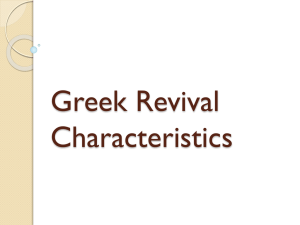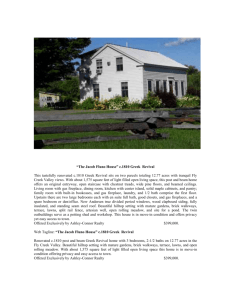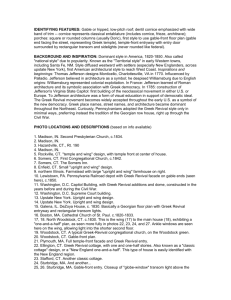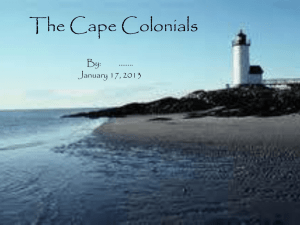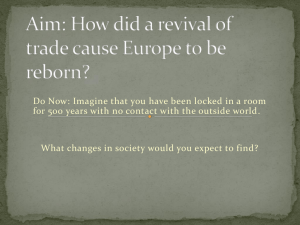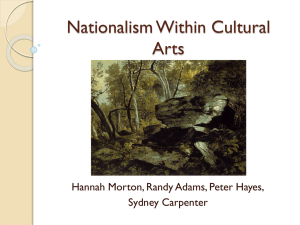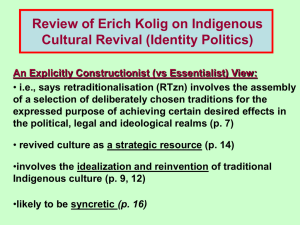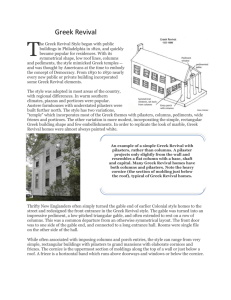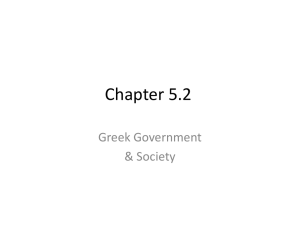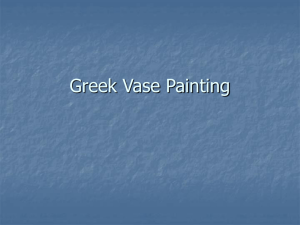AP-Art-Hist-Intro-PPT
advertisement
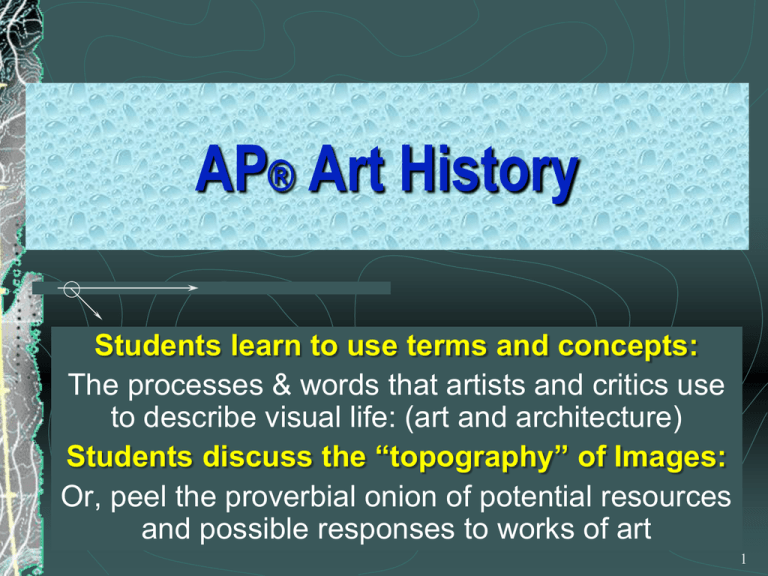
AP® Art History Students learn to use terms and concepts: The processes & words that artists and critics use to describe visual life: (art and architecture) Students discuss the “topography” of Images: Or, peel the proverbial onion of potential resources and possible responses to works of art 1 Quality over quantity… Elliot Eisner. Professor Emeritus of Education at Stanford University. "The act of representation is more of a dialogue than a monologue, more of a conversation than a lecture" (1983). “With the arts, children learn to see… …We want our children to have basic skills. But they also will need sophisticated cognition, and they can learn that through the visual arts.” 2 In, “The Arts and the Creation of Mind” (2002), Elliot Eisner, professor of education and art at Stanford University, writes… Experience is central to growth because experience is the medium of education. Education, in turn, is the process of learning to create ourselves…Work in the arts is not only a way of creating performances and products; it is a way of creating our lives by expanding our consciousness, shaping our dispositions, satisfying our quest for meaning, establishing contact with others, and sharing culture. (p. 3) 3 Connecting Visual and Verbal Literacy Speak and write with appropriate Use of Art “Formalisms”: When you talk about art, consider how the “elements and principles of art and design” are deployed to communicate. Elements are parts: (lines, shapes, colors, forms, textures, spaces, value, etc.). Principles apply to the whole. (rhythm, balance, proportion, emphasis, and unity). In speaking and writing, we will pair elements and principles, using word phrases like “value” + “contrast” for example. Or, we could use “rhythmic + line” or “movement”. lines and contours used to make textures and forms 5 Composing forms & the “classical” pyramid Historical and Cultural Literacy Students will interpret historical and contextual connections: Learn to analyze the importance of artistic technologies & techniques. For example, in15th Cent Germany the wood block print and engravings did as much as printing press to communicate Western Religion to the intended audience. On the following slide, compare the combined religious, literary, and artistic impact of contemporaries, Martin Luther and Albrecht Durer… Durer’s symbolisms of Christian Humanism Personifications of a Catholic artist, influenced by Protestantism, surmised in Durer’s diary reference to Martin Luther as `that Christian man who has helped me out of great anxieties''. Art History: How old is it? Why is it important to know; and so what then? How old? (4 types of chronological evidence): 1) physical evidence (dating the materials); 2) documentary record (a dated written account with it) 3) visual evidence (period clothing and decorative arts) 4) stylistic evidence (the way the art looks; the art historian’s special area of professional expertise is often personally biased) What is a “style”, also called a “movement”: Period style refers to the characteristics that unify an artistic manner of approach that is repeated and refined across a culture or a time. Regional style, sometimes associated with “provenance”, refers to where a certain group of art works come from geographically Personal style: El Greco or Georgia O’Keefe: personal styles figured prominently in the development of 20th century modernisms. “Style Wars” in the French Salon (Les Academies Des Beaux Arts): The Poussinistes (below) vs. the Rubenistes (rt) Personal Style El Greco, late 16th c. Georgia O’Keefe 11 Thomas Hart Benton: Personal & Regional 12 American Gothic by Grant Wood 13 “Classical Revival” is a great example of Period Style that evolves into Regional Styles in Art & Architecture Original Federal Period of 1780s and 1790s Thomas Cole founding the “Hudson River Valley School” of Painters of the Upper Hudson & Niagara Valleys, respectively. The Neoclassicism of Thomas Jefferson Regional Variations on the classical revivals of Greek styled buildings in the American North and South in the early 1800s 14 American “Classicizing Transcendentalist”: Thomas Cole’s “Course of Empires”, 1830s 15 Greek Revival in the U.S. began with Jefferson’s efforts to revive the classical past during America’s new Constitutional Period (1785 to 1792), now called the “Federal” Period (Virginia State Capitol). 16 Detail from Jefferson’s State Capitol 17 1824 Second Bank of the United States, by William Strickland 1832 Chapel, UGA Greek Revival Period Style in Public Buildings 18 Greek Revival Regional Styles in American Architecture of the 19th Century Greek Revival home in Marshall built 1838; oldest 19 brick residence in Michigan More than a Ninja Turtle…Leonardo, Michelangelo, Raphael #26 thru 28 20 What style is Caravaggio? 21 Claude Monet, Impression Sunrise, 1872 One of the first “MODERN” Paintings? . . . 22 What do you remember about Van Gogh? Is there much more to say about him? 23 Dali’s Surrealism, “The Persistence of Memories” 24 What medium or approach to art is this? 25 #38 26 “F-111,” from the art movement of American Consumerism in the 1960s How did Pop Art influence Pop Culture, and vice versa? 27 III. 28 Ladies Jeans Pockets: An extra credit opp. 29 Reductive Michelangelo’s Prisoners 30 Additive (Lost Wax Bronzes of Benin Culture and Rodin) 31 Learn to read architectural plans & elevations 32 Van Gogh. Flowering plum tree – Japonaiserie (1887). (Asian influence in the West) Non-Western Perspective in a Japanese Silk Painting Delightfully different goals from Western Art! 34 THANK YOU FOR COMING TONIGHT!!! Hope that you will sign up, and I look forward to seeing each of you in enrolled in my AP Art History course! Winslow Homer. “The New Novel” (1877). Watercolor Museum Visit Example 35
